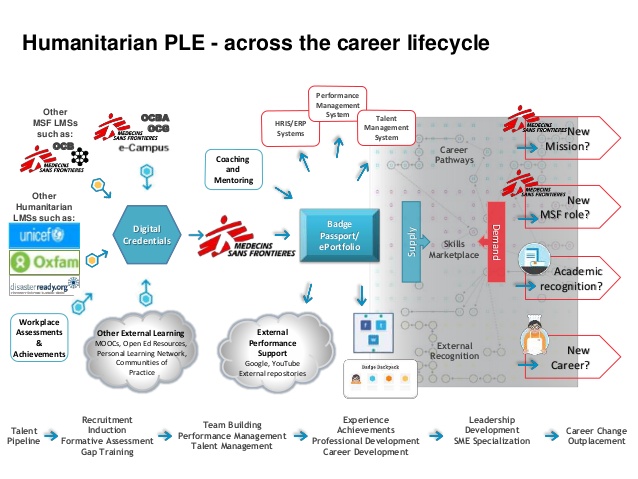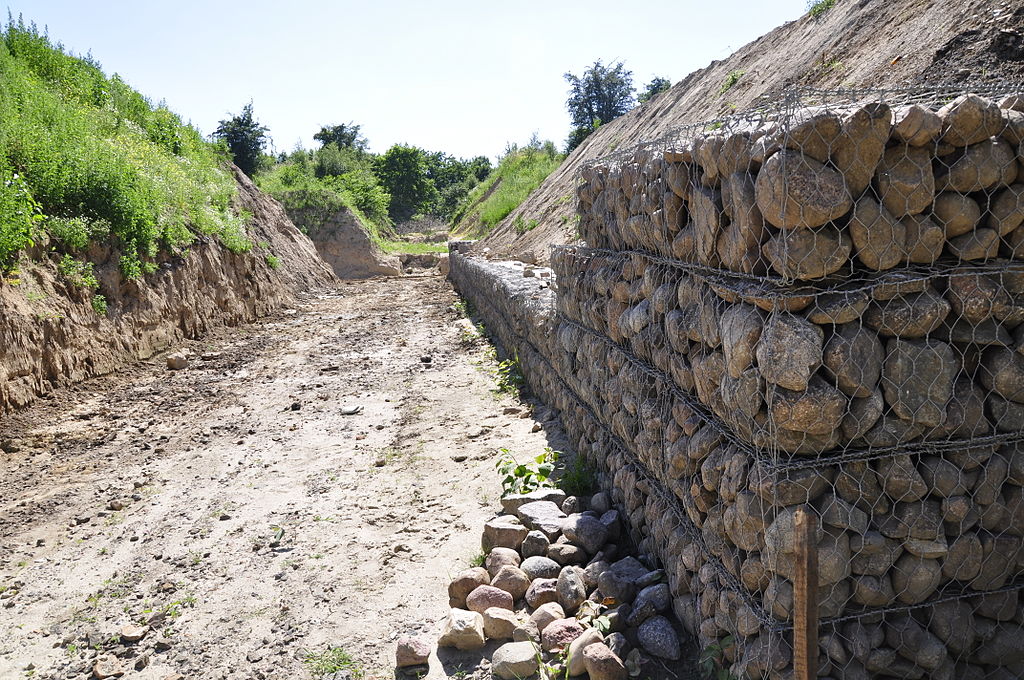This post is a response to a post on cogdogblog where Alan Levine was questioning the value of Open Badges as a credential system: Seeking Evidence of Badge Evidence. Although the post was mostly about the crappy evidence practices of many badge issuers and the need for evidence (I say sometimes yes, sometimes no), one of Alan’s thoughts struck me all the more when it was endorsed by Stephen Downes in OLDaily:
“being badged is a passive act, even with blockchain secure authority, it is done to you. As important is what you do yourself, in active tense, to demonstrate your own evidence. Get badged, yes, that’s one part of showing what you have done. But get out there, get a domain, and show the world what you can do. That is evidence.”
Alan’s post has sparked an interesting series of comments that will culminate in Alan joining a Badge Alliance Community Call on Wednesday March 9 at 12pm ET. This is my contribution ahead of time.
My post is also doing double duty as an assignment for #NRC01PL, the Personal Learning cMOOC now underway led by Stephen Downes and linked to NRC’s multi-year Learning and Performance Support Systems initiative.
At this point, the MOOC is about to move on from blasting the poor LMS for its preoccupations with highly-controlled instructional design, over-reliance on content delivery with tied assessment, and limited options for deeper learning through practice, experience and reflection. Interesting not just for its timing, Donald Clark’s latest blog post hits a lot of these points but also talks about the benefits of the LMS, helping make the case for Phil Hill’s Minivan of Education.
As a new blogger but longtime user of Slideshare, my post builds on a presentation about PLEs that I delivered at ePIC 2015 on behalf of MSF Canada with Dominique Giguère of Currents Group:
[slideshare id=49221246&doc=badgeenabledplev21epicforupload-150610131519-lva1-app6892]
The key slide (39) is here – my idealized vision for a badged humanitarian career:
The point I want to make in this post is that sometimes even self-directed learners need to be recognized in order to build their professional identity and achieve their goals. And it doesn’t always have to mean bowing down to The Man, whether that be an employer or your nearest institution.I think this is important in the context of #NRC01PL, MOOCs in general and Open Educational Practices as a mindset. As eLearning Provocateur put it so succinctly in a post about 70:20:10 (Personal Learning applied to the workplace),
I’m an advocate of informalising the learning, and formalising the assessment. eCredentials have an important part to play in the latter.
I should emphasize here that my interest goes way beyond higher education and well into the workplace. And while blogs can be a great way to learn out loud, hone your wits in public and build a connected body of work in certain fields, I don’t think a blog can do it all for everybody, and it may be wholly inappropriate to some recognition contexts.
How many blogging industrial welders do you know, for example?
UPDATE: Alan Levine has found two… see comment
Open Badges Don’t Have to Suck
Yes, many badges do suck – cue the military metaphors:

Carpet Badging @kyledbowen CC BY-SA
But that’s like saying WordPress sucks because so many people use it poorly, or for things you hate. Sturgeon’s law: 90% of everything is crap. Focus on the 10%.
An Open Badge is a tool for recognizing and communicating learning. Like any tool it can be used poorly, imperfectly or, as I like to say, “in the spirit of continuous improvement.”
Badge Earners Aren’t Passive
I’m not even sure that passive is the right word. I think what Alan and Stephen mean is dependent, as in not independent or self-directed; what Serge Ravet referred to in his comment to Alan’s post as an asymmetrical power relationship where:
“authorities” (have) the “right to trust” while the average punter has only the right to beg to be trusted by an “authority.”
(I love it when Serge talks Cockney.)
It’s not passive because badges are owned by the earner. Yes, a badge “victim” may be sent a badge for being randomly awesome, for showing up at a conference, or for completing some algorithmic idiocy (you logged in!).
But he/she can refuse the badge – that’s at least passive-aggressive. And they can decide to actively share the badge to further their goals if the badge has transferable meaning for them and the audience they are sharing with, such as employers. And then there are other ways to earn and use badges that I go into below.
Attaching a label to a person that the person has no control over – that’s passive.
My Premises
Open Badges are more than Digital Badges
Like many, I make a big distinction between Open Badges and Digital Badges, although the former is technically a subset of the latter, and I’ll cite Doug Belshaw again here:
For me, Open Badge = eCredential = micro-credential = modular credential = a technically portable, potentially socially transferable statement of learning or achievement.
When I say digital badges I generally mean the kind that are not technically portable or socially transferable. They can have localized merit, but are not the focus here. The problem is when badge issuers mindlessly use Open Badges for digital badge purposes, i.e. issue Open Badges with no thought to how they could have transferable value and how to make that happen.
People want to be recognized in different ways at different times
There are times when even self-directed learners need to have their learning and capabilities formally or semi-formally assessed and recognized for specific purposes, such as a mid-careerist transitioning to back to education or to a new occupation, or a skilled immigrant transitioning to a new workforce.
The phrase Recognition of Prior Learning (RPL, also PLAR or PLA) will likely leave behind most of the university sector (colleges support it), but the notion behind it is what first brought me to Open Badges via ePortfolios: recognizing what someone knows and can do, based on assessing authentic evidence that can be selected from lifewide learning (formal, nonformal, informal/experiential) and has been curated, annotated and aligned for a particular purpose(s).
It’s an important set of processes and values for adult learning. It’s all about fairness: recognizing learning, no matter where it was gained.
AAEEBL will tell you that you can also have formative portfolios FOR emergent learning, but I’m speaking here mostly about summative portfolios OF past learning that are designed for recognition for a specific reason: academic credit, admission, professional registration, hiring, promotion, etc. These are increasingly known as “Targeted Evidence Packages” to avoid the word “portfolio”, which has baggage in some circles as being synonymous with sprawling life stories in loose-leaf binders (or piled up in a blog, or scattered across the Internet).
I’d call them micro-portfolios, because their curated content is typically a subset of a larger portfolio that can have many ongoing purposes, including learning: front display case vs. back workshop.
Assessing Self-Directed Learners
Assessment is not just about tests
Up here in Canada, we’ve done a lot of work improving and clarifying our RPL practices, especially for regulated professions. One reason for this is to make things fairer for immigrants and refugees. A lot of it is about getting away from high stakes exams as the weapon of choice and thinking about more authentic and fairer ways to assess capabilities.
According to this 2012 guideline for assessing skilled immigrants from the Canadian Association for Prior Learning Assessment (CAPLA), there are five main kinds of assessment, each with pros and cons, which are often used together in varying combinations:
- Self-Assessments
Typically formative, can be self-directed or interpretive, i.e. shared with others - Written Examinations
Criterion referenced (simple cut score) or norm-referenced (Bell curved) - Oral Questioning
Formal/informal, structured/unstructured. Can even be a collaboratively structured “professional conversation”, an interesting practice which I’m going to follow up on later. - Demonstrations and Observations
Workplace assessments over time and event-based simulations, such as the medical Objective Structured Clinical Examination (OSCE) - Portfolios and ePortfolios
Portfolios FOR learning and/or Portfolios OF learning (Formative and/or Summative)
I don’t know about you, but I could drive an Open Badges recognition truck through all this – or is that a B-2?

Meet me in St. Louis, Louis… Public Domain
For example:
- Self-Assessments
a) Declarations of interest and belief, such as Serge Ravet’s example of Je suis Charlie. These can begin to get at soft skills, but can obviously be gamed.
b) Self-issued, self-regulated badges, aligned to clear standards, linked to examinable evidence, based on models such as Continuing Professional Development (CPD) in several professions and program review in academic institutions. Use for both continuous improvement and evaluation by others. Evidence and badge issue can be evaluated and endorsed after issue by standards bodies and other stakeholders, which adds value over time. Currency maintained by a stream of continuing evidence, with or without additional external recognition. I recently suggested this as a model to an impoverished professional body seeking sustainable ways to improve its CPD. - Written Examinations
a) Career Readiness badges.
Employers already test for literacy, numeracy and document use for front line candidates. NOCTI’s Job Ready and College Ready Assessment badges can save time and money for candidates and employers and reduce the waste of lost assessments that could be transferred from the immediate hiring or admissions context (testing, re-testing…)
b) Language testing
MSF Brussels’ evolving competency model includes the leveled Common European Framework of Reference for Languages. This and other language frameworks are testable and displayable and can be used for recruiting in the workplace or for HE admissions.
c) Health and Safety compliance testing – not a biggie for most of the audience reading this post, but useful for candidates who need them to be recruited or retained. And for the employer. - Oral Questioning
a) DeakinDigital’s video interview as triangulation for their portfolio assessment (see below)
b) Language testing, perhaps for Canada’s Portfolio Based Language Assessment (PBLA) for immigrants. When is PBLA going to make the transition to ePortfolio anyway?
c) Audio/video recordings could be supporting evidence for “professional conversations” badges, or even asynchronous behavioural interviews. - Demonstrations and Observations
a) The best example I have at the moment is Lipscomb University’s OSCE for Business Leaders (my term – maybe it should be OSLE), where leadership-related soft skills are evaluated in workplace simulations within a controlled environment.
b) Vocational Training. There is huge potential for more authentic, modular, progressive, experience and practice-based alternatives to the dysfunctional national Red Seal apprenticeship system in Canada, with its isolated and often disruptive formal learning semesters, opaque experientialtimecardlogbook and multiple choice exam as afinal hoopcapstone. The logbook could be a beautiful digital thing made of many badges with linked evidence. But there are barriers… sadly, few of them related to learner needs. The Manufacturing Institute in the US is working on this, but I also advise keeping an eye on City & Guilds in the UK. Their TecBac is a good start. - Portfolios and ePortfolios
DeakinDigital formally badges Masters level Recognition of Professional Practice, based mostly on ePortfolios (Targeted Evidence Packages), supplemented by other assessment as needed (known as triangulation in RPL parlance). It’s my fond hope that MSF will support something like this for its leadership pipeline.
Blogs are not enough
Alan Levine and Stephen Downes both say that the evidence of their capabilities is in their output. Well, they’re blogging rock stars with thousands of followers who appear to blog as easily as they breathe. They’ve built their credibility through their output over time and that gets them work and speaking engagements in the post-secondary edtech community. They have huge social capital. They don’t need no stinkin’ badges.
But what if they were going through a career transition and needed to re-establish themselves in another community that doesn’t know them and doesn’t have the time to read all their blog posts? That’s essentially what happens to immigrants, for example. (Think about all those Americans fleeing to Cape Breton if Trump Wins.) What if they were BAs just graduating?
And not all of us are bloggers. I’m a recently hatched blogger and I’m finding that it takes significant effort to maintain the channel.
Also, blogs aren’t equally useful across sectors, however great a fit they are for the post-secondary edtech community. The industrial welder is just an extreme example.
Personal learning implies personal evidence that’s appropriate to context. It takes a ton of effort to assemble an ePortfolio or a blog. It takes a ton of effort to evaluate one, which is a key barrier to their acceptance. Trustable proxies like Open Badges can help. They can include direct evidence or BE indirect evidence nuggets (more RPL parlance), with trust. More on that in future posts.
Open Badges can help structure and reinforce blogs and ePortfolios
If we’re talking about past learning, I see a person’s body of work and the sum of their experience as similar to a swampy archaelogical site or an unexploited mine. For ongoing work and learning, maybe an abundant wetland estuary.
It requires investigation, cooperation with others, triage, channeling, sifting, extraction, refinement, construction and packaging before you can develop transferable value from the raw materials that different audiences will recognize in environments where you want to build your social capital.
So I say that Open Badges can be like structural supports for a person’s body of work, like gabions for an embankment or corduroy roads in a wetland. Signposts, like localized GIS markers or 3D beacons helping you map and leverage your assets.
These hardened pieces of validated (and ideally aligned) evidence can support other kinds of evidence to tell your learning story.
So I’m going to be asking Stephen for a badge if I complete this MOOC. But I want a good one that I can use somewhere else…hmm, maybe at DeakinDigital?


Thanks so much Don, I have my reading assignments lined up for Wednesday. Let me admit that my assertions were intentionally over-generalized because I hoped to generate some discussion like this. I could have written it much more in an open questioning tone.
I have a lot to learning in the open badging space.. Like most things, it turns out to be more complex then a few paragraphs can summarize.
I have no interest in a Blogs vs Badges smackdown; that is pointless. There are elements of both that are compelling and yes, plenty of fumes of Sturgeon’s Law everywhere.
I’m looking forward to our conversation.
PS. The internet is a big place 😉
Joe Welder https://www.arc-zone.com/blog/joewelder/
The Welding Life http://theweldinglife.com/
Thanks Alan.
I guess you got what you asked for in your pointed way. I’m really looking forward to all the discussion you’ve helped generate. I think we both agree it’s not about Blogs vs Badges. #morethanfriendswithbenefits as Kate Coleman likes to say.
BTW, good one with the welder blogs! Or is that two ? I forgot to Google that in my rush to publish. Talk about honing your wits in public. Now if only we could map those two against all the edtech blogs…
Pingback: Personal Learning Ecosystems as an “Internet of Badge Things” | Littoraly
Nice post. I tend to agree that blogs (or publication) as evidence of learning falls short in the vast majority of occupations. I love the example of welders as I’m often using it myself. I did learn welding at school so I know the craft. It was nice to find two examples but let’s look again. On the two links shared by Alan, one belongs to a company selling welding equipment and showcase a typical user, the other is .. a teacher. It’s good we use blog for sharing ideas but it shouldn’t be used as model.
Badges are way more usable, everybody can understand it and gain badges in his field. A vocational community can issue them locally. Easy.
Halfway between blog and badges are portfolios. It’s kind of buzzword nowadays but it could be expanded to everything. A collection of pictures of welding masterpieces on flickr could be such a portfolio. It’s open to public eyes, it’s only about taking pictures, it’s free. Now I got hundreds of them.
Example: https://www.flickr.com/photos/99979474@N08
Hi Bruno: Thanks for this example. I’m all about badges AND portfolios to tell fuller story. My only wish for this example is if I could see notes about the pictures re problems solved, etc. I’d love to work with others to build an environment for that kind of vocational eportfolio.
Heck it’s not going to happen often. I have always been in contact with craft people. I recently spent an afternoon with a local stonecutter. A young guy 25y who started as solo-entrepreneur. I explained him he should setup a website and show what he is doing. Taking picture was ok, Explaining on a short video what was solved, what was the interesting aspect of this particular work was too much asking. He is passionate of his work. he would spend hours sharing about it with anyone but by himself, speaking or writing is an obstacle.
Back to the reason of my visit today to prepare #PKMChat later today, that’s where interdependence and learning network pops in. What the wouldn’t do on his own he has no difficulty explaining to a peer even if it is recorded. Posting simply afterward is OK. Forget writing, lot of people just don’t feel like sitting in front of an empty page. Got the same problem in KM.
Good point, and we encourage buddy pairs in ePortfolio work; interview each other, validate, etc. Less lonely, less pressure.